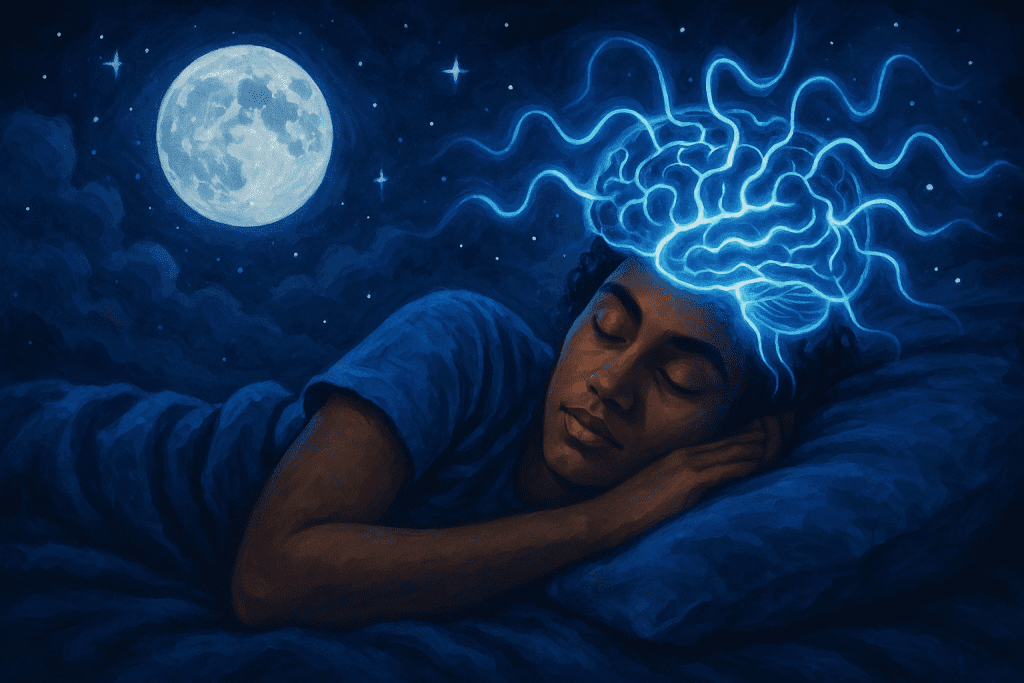
Introduction to Brainwave Entrainment
Sleep is one of the most vital elements for overall health, yet millions struggle with insomnia, poor sleep quality, or restless nights. In the search for natural solutions, brainwave entrainment has emerged as a fascinating method to help the brain ease into restful states.
Brainwave entrainment techniques interact with the neural activity of the human brain, encouraging patterns that promote relaxation and sleep.
But does it actually work? Let’s break it down.
Understanding Brainwaves
Our brains operate on different frequencies, known as brainwaves. These are also referred to as brain waves and represent oscillatory activity in the brain.
- Delta waves: deep sleep, regeneration
- Theta waves: light sleep, dreaming
- Alpha waves: relaxed wakefulness
- Beta waves: alert, focused state
Brain waves can be measured across a wide frequency range, and their patterns at any given moment reflect our current mental or emotional state.
These brainwaves shift naturally throughout the day and night, influencing how deeply and restfully we sleep. Researchers often study brain waves during a resting state to establish a baseline for comparison with other mental activities.
What is Brainwave Entrainment?
Brainwave entrainment is the process of using external stimuli usually sound or light to synchronize brain activity to a specific frequency, where these periodic stimuli can cause brainwaves to become entrained to the same frequency as the external input. It has roots in ancient practices like rhythmic drumming but has now evolved into a technology-backed sleep aid.
Different brainwave entrainment techniques use specific frequencies to target desired brainwave states, and in the case of binaural beats, a carrier frequency often between 100 Hz and 900 Hz is selected to optimize the effectiveness of the entrainment process.
Types of Brainwave Entrainment
Brainwave entrainment offers a variety of noninvasive methods to influence brainwave activity, each harnessing different frequencies and stimuli to promote relaxation, cognitive enhancement, and better mental health. Here’s a closer look at the main types of brainwave entrainment and how they work:
- Binaural Beats: This popular technique uses two slightly different frequencies, one played in each ear, to create a third tone known as a binaural beat within the brain. The resulting pulsing sound encourages the brain to synchronize its activity to the difference between the two frequencies, helping to induce meditative states, support relaxation, and improve sleep quality.
- Monaural Beats: Unlike binaural beats, monaural beats use a single tone that pulses at a specific frequency, delivered through one speaker or both ears simultaneously. This method produces rhythmic stimulation that can be effective for those who prefer not to use headphones or have difficulty perceiving binaural beats.
- Isochronic Tones: Isochronic tones are single tones that turn on and off at regular intervals, creating a distinct, rhythmic pulsing sound. This type of audio entrainment is known for its strong, clear beats, making it especially effective for enhancing focus, supporting cognitive function, and promoting relaxation.
- Audio-Visual Entrainment (AVE): AVE combines auditory stimuli, like pulsing sounds, with visual stimuli such as flickering lights or strobe lights. This multisensory approach can help entrain brainwaves more deeply, guiding the brain into states of deep relaxation, meditative states, or heightened alertness, depending on the chosen frequency band.
- Transcranial Magnetic Stimulation (TMS): TMS is a noninvasive method that uses magnetic fields to stimulate specific areas of the brain. While often used in clinical settings for treating depression and other neurological or neurodegenerative disorders, TMS can also influence brainwave activity and support mental health.
- Gamma Entrainment: This technique targets the gamma frequency band (typically above 30 Hz), which is associated with higher-order brain regions, cognitive enhancement, and mental clarity. Gamma entrainment can be achieved through auditory, visual, or tactile stimuli, and is being explored for its therapeutic potential in ageing and neurodegenerative conditions.
- Visual Entrainment: Using flickering lights, strobe lights, or other visual stimuli, this method entrains brainwaves by providing rhythmic visual input. Visual entrainment is often used for relaxation, stress relief, and to support meditative states.
Each of these brainwave entrainment techniques can be used alone or in combination, allowing individuals to tailor their approach to their unique needs whether that’s improving memory, achieving a meditative state, or simply winding down for better sleep. By exploring different frequencies and types of rhythmic stimulation, you can discover the method that best supports your brain’s natural rhythms and overall well-being.
Techniques of Brainwave Entrainment: Binaural Beats and More
- Binaural beats: Two slightly different tones in each ear that the brain blends into one frequency.
- Isochronic tones: Pulsating beats at specific intervals.
- Monaural beats: Single tones that create a rhythmic effect.
- Light and sound devices: Visual flashes combined with tones to guide the brain.
The Science Behind Brainwave Entrainment
The key lies in something called the frequency following response (FFR). When exposed to a repetitive stimulus, the brain naturally synchronizes its activity. Researchers often use EEG (electroencephalography) to measure the brain’s oscillatory activity and assess the effects of brainwave entrainment. This can nudge the brain toward states associated with deep relaxation and sleep.
Sleep and Brainwave Patterns
Sleep happens in stages:
- Stage 1: Light sleep (theta waves)
- Stage 2: Onset of sleep (spindles and theta waves)
- Stage 3 & 4: Deep sleep (delta waves dominate)
- REM sleep: Dreaming stage (mixed brainwave activity)
Each stage is associated with distinct brainwave states, which can be targeted using brainwave entrainment techniques. Entrainment methods often use binaural beat frequencies within a certain frequency range such as theta or delta bands to promote transitions between sleep stages.
By targeting the right brainwave frequencies, entrainment can potentially smooth the transition between stages and promote deeper sleep.
Can Brainwave Entrainment Improve Sleep Quality?
Both pilot studies and larger trials have investigated the effects of brainwave entrainment on sleep. Research shows promise. Some studies found that listening to delta or theta wave entrainment helped participants fall asleep faster, experience deeper rest, and reduce symptoms of insomnia.
Researchers have tested different binaural beat frequencies to determine which are most effective for sleep improvement. Additionally, some studies have observed increased theta power in participants using brainwave entrainment for sleep.
While not a miracle cure, it can be a useful tool for better sleep hygiene.
Brainwave Entrainment and Relaxation
Stress is a major sleep disruptor. In addition to reducing stress, brainwave entrainment has shown potential for alleviating pain in some studies. Brainwave entrainment helps reduce stress by stimulating alpha and theta waves, which are linked to calmness and meditative states. Think of it as a “shortcut” to relaxation before bed.
Practical Applications
Today, there are plenty of options:
- Apps offering binaural beats for sleep
- Wearable headbands that track and stimulate brainwaves
- Guided meditation tracks combining entrainment with mindfulness
Some of these devices are also marketed for their potential to enhance cognition by using brainwave entrainment to influence mental functions and support focus.
Benefits Beyond Sleep
Interestingly, users often report improvements not just in sleep, but also in:
- Focus and memory
- Reduced anxiety
- Improved mood regulation
With regular use, individuals may experience all the benefits associated with brainwave entrainment, from better sleep to improved mental clarity.
Potential Risks and Misconceptions
Despite its benefits, there are a few things to note:
- Some people may experience mild headaches or dizziness.
- It’s not suitable for those with epilepsy (due to flashing light entrainment).
- It’s not a replacement for medical treatment.
Tips for Using Brainwave Entrainment for Sleep
- Listen with stereo headphones (for binaural beats).
- Set sessions for 20–40 minutes before bed.
- Use it as part of a consistent bedtime routine (dim lights, no screens, calm environment).
Brainwave Entrainment vs. Other Sleep Aids
Unlike melatonin or medication, entrainment works by gently guiding the brain, not by altering body chemistry. Systematic reviews and meta-analyses have compared the effectiveness of brainwave entrainment to other sleep aids, highlighting its unique approach. Research reviews, such as those published in Res Rev and Ageing Res Rev, have explored the broader impacts of brainwave entrainment on sleep and neurological health. It’s more dynamic than white noise, which only masks external sounds. Combined with CBT-I, it can be part of a holistic sleep strategy.
Real-Life Experiences
Many users describe it as “meditation made easy.” Instead of struggling to quiet the mind, entrainment naturally leads to calmness. While results vary, plenty of testimonials point to more restful nights and better energy during the day.
Conclusion
So, can brainwave entrainment enhance sleep? The answer is yes with balance. It’s not a magic fix, but when used consistently, it can help the brain shift into the right state for deep, restorative rest. For those seeking a natural, non-invasive way to improve sleep, it’s worth exploring.




